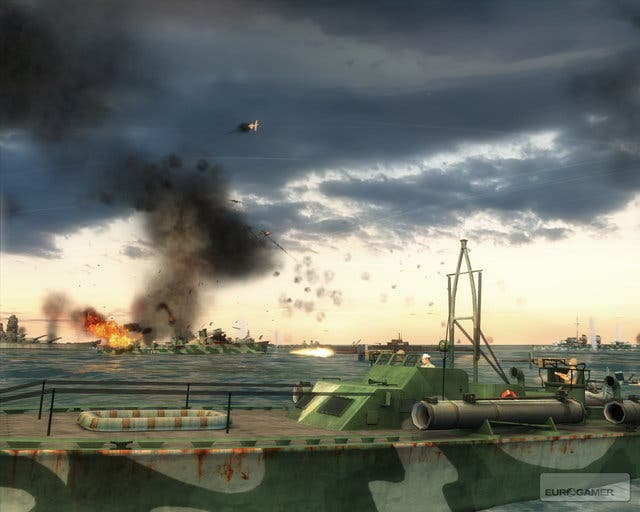Battlestations Midway
God of war.
Just when it looked like World War II games had been done to death, Eidos goes and releases one of the most ambitious and accessible ever made and scores a chart-topping hit in the process. Whodathunkit?
Developed at Eidos' new in-house studio in Hungary (of all places) over, ooh, many years, it's the latest in a looong line of videogames to tackle the infamous Pacific Theatre portion of the second world war. Kicking off at the attack on Pearl Harbour in 1941, you follow the events of naval recruit Henry Walker on his rise through the ranks, culminating with the epic battle for Midway. Via planes, boats and even submarines, it's a game very keen to try a different approach - and very nearly pulls it off.
Cross pollinating the chin-stroking world of strategy gaming with white knuckle action always sounded like the improbable dream of an overexcited marketing team. "You can play it like an action game, or direct the battle like an RTS," they'd tell us. We'd nod politely at the bold claims and enthusiastic demonstrations, but could never see how it could work properly without seriously alienating both audiences at the same time.
False start

And those feelings don't go away when you first get your hands on it. For a start, the game lacks a real hook for the first few missions of the main campaign mode, making them feel bland and depressingly easy to complete. Guide this boat to that way point, point your reticule over there, shoot those targets, full steam ahead, make your escape, yawn loudly and hope that this isn't all there is to it. Not a good start.
The early flight missions are just as mundane, too, with floppy handling that made us wish that Totally Games would hurry up and make another flight combat game and show everyone how it's done (again). On the plus side, the extra development time afforded to Eidos Hungary has allowed it to produce a game that's undeniably polished and extremely impressive to look at, but the first hour or two with the game does very little to suggest that its chart topping performance was deserved.
But then the game starts handing your arse back to on a plate, almost sensing your indifference and daring to prove you wrong. Hitting this unexpected and inexplicable brick wall on the fifth mission (Raid on Balikpapan) made us realise that playing the tutorial might be a good idea after all - only to rub salt in the wounds by providing us with officially the world's longest gaming tutorial in history.
Too much information

Fully an hour later, the 11-part tutorial was over - at which stage you're either the most qualified battle tactician or just horribly bored and confused. Fortunately, some of it is well worth paying attention to, and actually makes the difference between being able to enjoy the game or not. Sure, being shown how to pilot aircraft, boats or submarines feels beyond pointless, but majority of the tutorial offers much-needed encouragement with the tactical side of the game.
Just as tempting as skipping the lengthy tutorial is to try and play Battlestations Midway like a standard 3D action game, mainly because a) being in direct control of ships or planes seems the more exciting thing to do. B) the dual stick movement/camera control system feels intuitive enough to fool you into thinking you can take on the Japs by yourself. C) It's a fine looking game. You didn't buy that giant flatscreen high def TV to look at a bland map screen, did you? But unless repeat failure is your idea of fun, it's not a game that allows you to be gung-ho.
So, with thoughts of the tutorial still firmly in mind, it seemed like a sensible idea to bite the bullet and attempt a more strategic approach. So with a weary heart we started switching to the boring but effective map screen more often and began experimenting with giving the AI more responsibility in battle. This more hands-off approach to the task at hand turned out to be a smart move.


